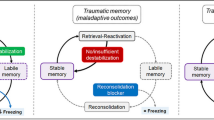Abstract
In the present study the role of the amygdala is demonstrated in the effect of antidepressant drugs on passive avoidance learning in bulbectomised rats. Imipramine, amitriptyline, or fluoxetine injected bilaterally (2×10 μg) into the medial part of the amygdala improves passive avoidance learning by bulbectomised rats. Systemic pretreatment with metergoline attenuates the effect of local imipramine or fluoxetine injection. Microinjection of serotonin but not noradrenaline into the amygdala improves passive avoidance learning by bulbectomised rats. The relevance of the amygdala in the behavioral effects of antidepressants in animals is discussed.
Similar content being viewed by others
References
Babington RG (1977) The pharmacology of kindling. In: Hanin J, Usdin E (eds) Animal models in psychiatry and neurology. Pergamon, Oxford, p 141
Belluzzi, JD, Grossman SP (1969) Avoidance learning: longlasting deficits after temporal lobe seizure. Science 166:1435–1437
Beretta C, Glässer AH, Nobili MB, Silverstri, R (1965) Antagonism of 5-hydroxytryptamine-induced bronchospasm in guinea-pigs by 8 β-carbobenzyloxy-aminomethyl-1-methyl-10α-ergoline. J. Pharm Pharmacol 17:423–428
Broekkamp CL, Garrigou D, Lloyd KG (1980) Serotonin-mimetic and antidepressant drugs on passive avoidance learning by olfactory bulbectomised rats. Pharmacol Biochem Behav 13:643–646
Broekkamp C, Van Rossum JM (1972) Clonidine induced intrahypothalamic stimulation of eating in rats. Psychopharmacologia 25:162–168
Cain DP, Corcoran ME (1978) Kindling in olfactory-lesioned rats. Behav Biol 22:264–268
Cairncross KD, Cox D, Forster C, Wren AF (1978) A new model for the detection of antidepressant drugs: olfactory bulbectomy in the rat compared with existing models. J Pharmacol Methods 1:131–143
Cairnccross KD, Cox B, Forster C, Wren, AF (1979) Olfactory projection systems, drugs and behaviour: a review. Psychoneuroendocrinology 4:253–272
Cairncross KD, Wren A, Cox B, Schnieden H (1977) Effects of olfactory bulbectomy and domicile on stress induced corticosterone release in the rat. Physiol Behav 19:485–487
Dawes P, Redfern PH (1976) Changes in the conditioned avoidance behaviour of rats following the admisistration of drugs to the amygdala. J Pharm Pharmacol 28:Suppl 36P
Di Chiara G, Camba R, Spano PF (1971) Evidence for inhibition by brain serotonin of mouse killing behavior in rats. Nature 223:272–273
Ferrini R, Glässer A (1965) Antagonism of central effects of tryptamine and 5-hydroxytryptophan by 1,6-dimethyl-8β-carbobenzyloxy-aminomethyl-10α-ergoline. Psychopharmacologia 8:271–276
Golds, PR, Przyslo FR, Strange PG (1980) The binding of some antidepressant drugs to brain muscarinic acetylcholine receptors. Br J Pharmacol 68:541–549
Górka Z, Ossowska K, Stach R (1979) The effect of unilateral amygdala lesion on the imipramine action in behavioral despair in rats. J Pharm Pharmacol 31:647–648
Grossman SP, Grossman L, Walsh L (1975) Functional organization of the rat amygdala with respect to avoidance behavior. J Comp Physiol Psychol 88:829–850
Horovitz ZP, Leaf R (1967) The effects of direct injections of psychotropic drugs into the amygdala of rats and its relationship to antidepressant site of action. In: Brill H, Cole, JO, Deniker P, Hippius H, Brandely PB (eds) Neuropharmacology. Proceedings of the Vth C.I.N.P. Excerpta Medica, Amsterdam, p 1042
Horovitz ZP, Piala JJ, High JP, Burke JC, Leaf RC (1966) Effects of drugs on the mouse killing test and its relationship to amygdaloid function. Int J Neuropharmacol 5:405–411
Kamei C, Masuda Y, Oka M, Shimizu M (1975) Effects of antidepressant drugs on amygdaloid after discharge in rats. Jpn J Pharmacol 25:359–365
Karli P (1956) The norway rat's killing response to the white mouse: an experimental analysis. Behaviour 10:81–103
König JFR, Klippel RA (1963) The rat brain: a stereotaxic atlas of the forebrain and lower parts of the brain stem. RE Krieger, Huntington, NY
Malick JB (1976) Pharmacological antagonism of mouse-killing behavior in the olfactory bulb lesion-induced killer rat. Aggressive Behav 2:123–130
Myers RD, Hack DB (1978) 14C-dopamine microinjected into the brain stem of the rat: dispersion kinetics, site content and functional doses. Brain Res Bull 3:601–609
Pellegrino L (1968) Amygdaloid lesions and behavioral inhibition in the rat. J Comp Physiol Psychol 65:483–491
Raisman G (1972) An experimental study of the projection of the amygdala to the accessory olfactory bulb and its relationship to the concept of a dual olfactory system. Exp Brain Res 14:395–408
Rigter H, Van Riezen H, Wren A (1977) Pharmacological validation of a new test for the detection of antidepressant activity of drugs. Br J Pharmacol 59:451P-452P
Routtenberg A (1972) Intracranial chemical injection and behaviour: a critical review. Behav Biol 7:601–641
Scalsa F, Winans SS (1975) The differential projections of the olfactory bulb and accessory olfactory bulb in mammals. J Comp Neurol 161:31–56
Sieck MH (1973) Selective olfactory system lesions in rats and changes in appetitive and aversive behavior. Physiol Behav 10:731–739
Siegel J, Murphy GJ (1979) Serotonergic inhibition of amygdala-kindled seizures in cats. Brain Res 174:337–340
Slangen JL, Miller NE (1969) Pharmacological tests for the function of hypothalamic norepinephrine in eating behavior. Physiol Behav 4:543–552
Tiffany PB, Mollenauer S, Plotnik R, White M (1979) Olfactory bulbectomy: emotional behavior and defense responses in the rat. Physiol Behav 22:311–318
Watanabe S, Inoue M, Ueki S (1979) Effects of psychotropic drugs injected into the limbic structures on mouse-killing behaviour in the rat with olfactory bulb ablations. Jpn J Pharmacol 29:493–496
Watson JB (1907) Kinaesthetic and organic sensation their role in the reaction of the white rat to the maze. Psychol Rev 8:Suppl. 21–100
Winer BJ (1971) Statistical principles in experimental design. Mc Graw Hill, New York
Wong DT, Horng JS, Bymaster FP, Hauser K, Molloy B (1974) A selective inhibitor of serotonin uptake. Lilly 110140, 3-(p-trifluoro-methylphenoxy) N-methyl-3-phenylpropylamine. Life Sci 15:471–496
Author information
Authors and Affiliations
Rights and permissions
About this article
Cite this article
Garrigou, D., Broekkamp, C.L. & Lloyd, K.G. Involvement of the amygdala in the effect of antidepressants on the passive avoidance deficit in bulbectomised rats. Psychopharmacology 74, 66–70 (1981). https://doi.org/10.1007/BF00431759
Received:
Issue Date:
DOI: https://doi.org/10.1007/BF00431759




